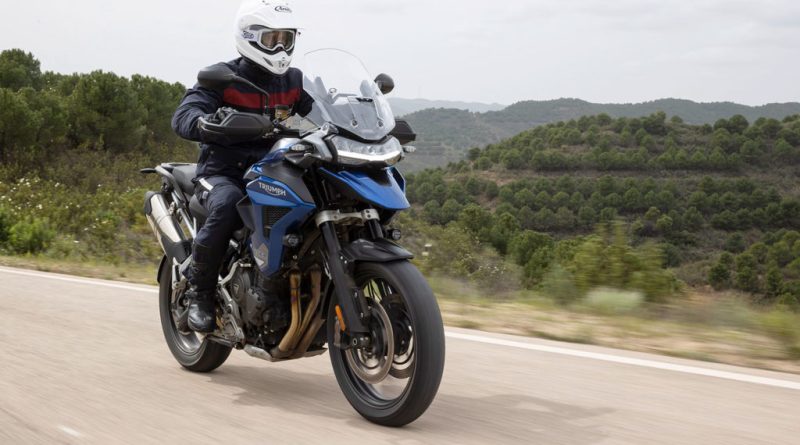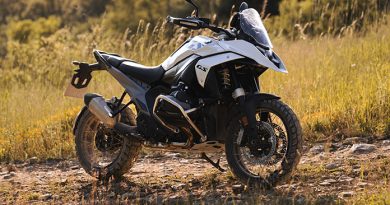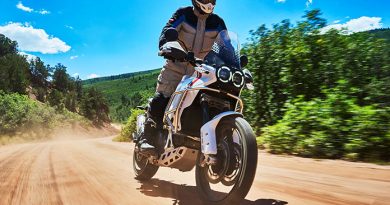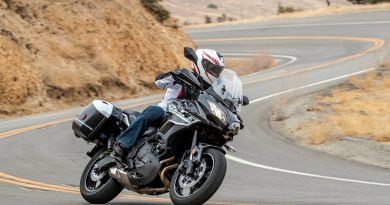2023 Triumph Tiger 1200 | First Ride Review
Overhauled for the 2023 model year, the new Triumph Tiger 1200 is available in five variants: GT, GT Pro (above), GT Explorer, Rally Pro, and Rally Explorer. Photos by Kingdom Creative.
Heavyweight adventure bikes are built to munch miles and tackle trails. The brief sounds simple, but balancing the demands of tarmac and terrain is a subtle art. Most manufacturers favor one side of the on-/off-road equation. Instead of splitting the difference, though, the 2023 Triumph Tiger 1200 splits the field, catering to long-haul road trippers with the GT series and intrepid explorers with the Rally variants.
The thoroughly updated Tiger 1200 didn’t just assume a split identity, it also went on a crash diet, shedding a claimed 55 pounds. To pack on extra muscle, Triumph repurposed the 1,160cc inline-Triple from the 2022 Speed Triple 1200 RS to pump out 148 horsepower (at 9,000 rpm) and 96 lb-ft of torque (at 7,000 rpm). Surround that punchy powerplant with a lightweight trellis frame, a cast-aluminum Tri-Link swingarm with shaft final drive, and Showa semi-active suspension, and you end up with one capable cat.
Check out Rider’s 2022 Motorcycle Buyers Guide
Up-spec street-oriented versions of the Triumph Tiger 1200 include the GT Explorer (left) and GT Pro (right). Designed for long-distance touring, Explorer models have larger gas tanks, heated seats, tire-pressure monitoring systems, and blind-spot radar.
The Tiger 1200 variants may share the same DNA, but they express different traits. The GT and Rally models have different headstock angles, suspension travel, damping rates, ride modes, and curb weights. Those differences allow the GT to pound the pavement while the Rally tears up the trail, with Pro and Explorer versions of each, the latter with more fuel capacity and other features for long-haul travel (including heated seats, a tire-pressure monitoring system, and blind-spot radar). With the latest-generation Tiger 1200 primed to take on the competition, we tested the GT Pro, GT Explorer, Rally Pro, and Rally Explorer (but not the base-model GT) variants on Portugal’s picturesque backroads and enduro tracks to determine whether these heavyweight adventurers can satisfy the needs of different ADV riders.
GO GET ’EM, TIGER
At the heart of the Tiger 1200 is Triumph’s liquid-cooled, 12-valve, 1,160cc inline-Triple engine. The mighty mill shares the same bore, stroke, and compression ratio as the Speed Triple 1200 RS, but a 270-degree crank, a 1-3-2 piston firing order, and shaft final drive endow the Tiger with a personality all its own. Those preparations outfit the Tiger 1200 for life on the open road and off the beaten path.
The Rally Pro and Rally Explorer variants are geared toward ADV riders who like to venture off-road. They have longer suspension travel, tubeless spoked wheels in 21-/18-inch sizes, knobbier tires, and more.
A steady torque curve and linear powerband make the Tiger ready to romp, with usable power throughout the rev range. In Tiger trim, the big Triple with a T-plane crank may not boast the most stimulating power profile in the class, but what the 1200 loses in outright horsepower numbers, it makes up for in character. Between 4,000-7,000 rpm, the engine emits a bellicose growl, and it roars up to its 9,500-rpm redline.
Unfortunately, that pleasing exhaust note is accompanied by extra vibrations just above 6,000 rpm. The footpegs buzz first and the vibes reach the bars in the higher registers. Luckily, the mill only spins 4,000 rpm at 70 mph in 6th gear, remaining comfortable for long-distance journeys. At a more spirited pace, those vibrations aren’t top of mind. During slower city riding, short shifting quelled the tremors and softened the power delivery.
The 2023 Triumph Tiger 1200 is powered by a 1,160cc inline-Triple derived from the Speed Triple 1200 RS. It makes 148 horsepower and 96 lb-ft of torque.
That same approach benefits trail riding, too. On the road, the direct line between the rider’s right wrist and the rear wheel lets the Tiger pounce out of corners. The torque-rich midrange that suits the road, however, can overwhelm grip in the dirt. The tractable Triple is just as happy to spin up or chug along, and I quickly adapted my inputs to the conditions. Triumph’s ride modes also help tame the Tiger.
Road, Rain, and Sport ride modes come standard on all models and adjust the Triple’s character accordingly. The GT Pro and GT Explorer add Off-Road and Rider (custom) modes, and the Rally Pro and Rally Explorer go one step further by adding an Off-Road Pro mode. Each mode dials the Tiger’s throttle response, damping settings, ABS, and traction control to the occasion, allowing the big-bore ADV to adapt to any environment.
When toggling through ride modes, the digital speedo/tach rotates out of the way on the 7-inch TFT display.
The Road and Rain modes live up to their names with usable power and increased ABS and TC intervention. The Tiger bears its claws in Sport mode, with a stiffened suspension, reduced traction control, and peppy throttle response that encourages a lively pace. Off-Road lowers the thresholds of both traction control and ABS actuation, while Off-Road Pro disables both for unfettered fun. With a dedicated button at the left switchgear, riders can quickly toggle between the ride modes while the Tiger is on the move.
ONE AGILE CAT
While the Tiger’s engine is the star of the show, its new Showa semi-active suspension is hardly an understudy. It offers automatic rear preload adjustment and two damping maps – Road and Off-Road – which are preselected with on-road and off-road ride modes, and damping is adjustable over nine levels within each map, from Comfort (soft) to Sport (firm). Users can fine-tune the settings on the fly to deal with pothole-strewn roads, fast-paced twisties, technical trails, long-haul cruising – you name it.
The new Triumph Tiger 1200 is equipped with premium components, such as Showa semi-active suspension, Brembo Stylema calipers, and Metzeler adventure tires. The street-oriented GT models have cast wheels.
Regardless of conditions, neither end of the nine-setting spectrum felt too spongy or hard-edged. Even in Comfort mode, the fork yields sufficient support under heavy braking without diving excessively. Conversely, the shock doesn’t buck the rider out of the seat in the Sport setting. Each mode prepares the chassis for differing conditions, but the system’s electronically controlled valves preserve the Tiger’s composure.
Users will inevitably find the suspension’s limits off the beaten path, but due to the Rally’s 8.7 inches of suspension travel and the GT’s 7.9 inches, bottoming the Tiger isn’t easy. Of course, a brisk pace on rutty trails will tax the suspension, but the semi-automatic system remained stout on the fire roads and technical singletracks we explored on the Tiger 1200 Rally Pro.
Although the updated Tiger 1200 lost a significant amount of weight, these are still heavyweight ADV bikes, with curb weights ranging from 540 lbs. for the GT Pro to 575 lbs. for the Rally Explorer.
Dustin’s Gear:
Helmet: Arai XD4
Jacket: Fuel Rally Raid Petrol Jacket
Gloves: Dainese MIG C2 Gloves
Pants: Fuel Rally Raid Petrol Pants
Boots: Alpinestars Tech 3 Boots
In concert with the adaptive suspenders, Triumph outfits the Tiger 1200 with superbike-worthy Brembo Stylema calipers. A Magura HC-1 radial front master cylinder provides precise feel and feedback at the lever, and braided hoses maintain consistent performance. The system’s finesse shined when modulating the binders on the trail, yet there’s more than enough bite and stopping power when hammering the brakes into a paved hairpin. The setup’s dependable braking performance increases confidence and complements the Tiger’s sporty ambitions.
Thanks to the communicative and responsive chassis, including a new, 12-lbs-lighter trellis frame, the Tiger 1200’s sharp on-road handling belies its 540- to 575-lb curb weight (depending on variant). The heavyweight adventurer feels light on its toes, and correcting a line mid-turn is effortless. As expected, the GT series attacks the tarmac best thanks to its 19-inch/18-inch cast-aluminum wheels shod with street-optmized Metzeler Tourance 90/10 tires. However, the Rally Pro and Rally Explorer are no slouches on the asphalt, even with 21-inch/18-inch tubeless spoked wheels shod with more dirt-oriented Metzeler Karoo tires. Despite the Rally’s slight disadvantage on the street, riders with even modest off-road ambitions will benefit from the trim’s capability without losing too much pavement performance.
The Triumph Tiger 1200 has a new Tri-Link swingarm with shaft final drive.
In the dirt, it’s easy to tell when the Tiger breaks traction, allowing the rider to adjust throttle application accordingly. After sliding the Tiger through several corners during the off-road day, a ham-fisted whack on the throttle quickly brought the rear wheel around. Luckily, the Off-Road mode’s traction control helped me save the potential low-side crash. Expert off-roaders will spring for the Off-Road Pro’s aidless experience, but the standard Off-Road setting’s safety nets will suit many novice-to-intermediate riders.
RIDE THE TIGER
The Tiger 1200’s ergonomics puts the rider in a commanding position to tackle both on- and off-road sections, with a roomy cockpit that offers enough space for the rider to move fore and aft. The two Explorer variants raise the handlebars to accommodate the larger 7.9-gallon fuel tank (up from 5.3 gallons on the GTs), but it doesn’t sacrifice comfort in the process.
The Tiger 1200’s windscreen is manually adjustable on the fly using one hand.
While the Tiger’s ergos fit my 5-foot, 10-inch frame, results will vary based on the rider’s dimensions and weight. The same goes for the windscreen. In the lowest setting, the screen pushed oncoming air up to my shoulders. The highest position shifted that current to the peak of my helmet, introducing reverberating wind noise and batting about my head. For that reason, I kept the one-hand adjustable screen in the low setting, but customers may remedy the situation with a windscreen extension from Triumph’s accessories catalog.
On the technology front, the Tiger 1200’s user interface is intuitive and straightforward. A dedicated home button on the right switchpod opens the primary menu, and a joystick at the left lets riders quickly toggle through settings. Unlike some of its competitors, the Tiger’s folder system is easy to navigate and requires a minimal learning curve. In certain modes, the 7-inch TFT display even prompts riders to revert to the previous ride settings, allowing users to seamlessly jump back on the trail without resetting ABS, traction control, and suspension damping options.
On Explorer models, the blind-spot radar system activates a light on the side-view mirror when a car or motorcycle is detected.
The Tiger’s new blindspot detection system, which is standard on the Explorer models, matches that convenience with safety. Similar to the tech found on the Ducati Multistrada V4 S, the Continental-developed system utilizes a rear-facing radar and mirror-mounted lights to inform riders when other vehicles enter their blindspot. The tech accurately detected both cars and motorcycles during my time with the Tiger 1200, but the light location doesn’t always grab the rider’s attention. Whereas the Multistrada places the notification lights at the top outer corner of each mirror, Triumph positions them at the lower edge, which may not be in the user’s line of view when looking far up the road. The system works just fine, but Tiger 1200 riders may want to do a double take before committing to a lane change.
Other useful features that are standard on the higher-spec Pro and Explorer models include cruise control, a quickshifter, cornering lights, hill hold control, LED auxiliary lights, heated grips, a centerstand, a skid plate, engine protection bars (Explorers and Rally Pro), and fuel tank protection bars (Rally Explorer).
An array of buttons and switches allow Tiger 1200 pilots to actuate functions and adjust settings. Heated grips are standard on all variants except the base-model GT.
OUT OF THE BAG
With the introduction of the 2023 Tiger 1200, Triumph returns its biggest cat to the adventure lineup. It may have taken Hinckley a few years to overhaul the heavyweight ADV, but the 55-pound weight savings, semi-active suspension, T-Plane inline-Triple, and other upgrades were worth the wait. The GT and Rally lines make all that fun accessible to both worldly travelers and rugged overlanders.
Pricing starts at $19,100 for the standard Tiger 1200 GT, which is competitively priced and equipped to take on its main rival, the BMW R 1250 GS. The higher-spec Pro and Explorer variants add more features to suit different on-road, off-road, and long-haul missions. The agility of the GT, GT Pro, and Rally Pro along with long-distance capabilities of the GT Explorer and Rally Explorer position the Tiger 1200 as a suitable option for all styles of adventure riding. Yes, balancing the demands of tarmac and terrain is a subtle art, but Triumph proves that it’s possible to have the best of both worlds. Choose your own adventure.
Geared toward ADV riders who like to get dirty, the Tiger 1200 Rally Explorer (left) and Rally Pro (right) are equipped with off-road-ready suspension, wheels, crash bars, and more.
2023 Triumph Tiger 1200 GT Pro / GT Explorer / Rally Pro / Rally Explorer Specs
Base Price: $21,400 / $23,100 / $22,500 / $24,200
Website: triumphmotorcycles.com
Engine Type: Liquid-cooled, transverse inline-Triple, DOHC w/ 4 valves per cyl.
Displacement: 1,160cc
Bore x Stroke: 90.0 x 60.8mm
Horsepower: 148 hp @ 9,000 rpm (claimed)
Torque: 96 lb-ft @ 7,000 rpm (claimed)
Transmission: 6-speed, hydraulically actuated slip/assist wet clutch w/ quickshifter
Final Drive: Shaft
Wheelbase: 61.4 in.
Rake/Trail: 24.1 degrees/4.7 in. (GT models) / 23.7 degrees/4.4 in. (Rally models)
Seat Height: 33.5/34.3 in. (GT models) / 34.4/35.2 in. (Rally models)
Wet Weight: 540 lbs. / 562 lbs. / 549 lbs. / 575 lbs. (claimed)
Fuel Capacity: 5.3 gals. (Pro models) / 7.9 gals. (Explorer models)
The post 2023 Triumph Tiger 1200 | First Ride Review first appeared on Rider Magazine.




